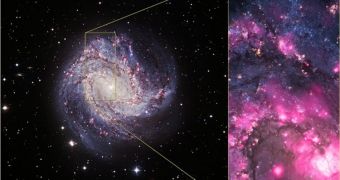A new paper, to be published in the May 10 issue of the esteemed Astrophysical Journal, details an amazing cosmic event that is currently taking place in the nearby spiral galaxy M83. Investigators discovered an ultraluminous X-ray source, which is part of a mysterious class of black holes.
The new investigation was conducted using the Chandra X-ray Observatory, one of NASA's four Great Observatories. Observations conducted after astronomers noticed an extreme outburst in a section of M83 produced direct evidence for a population of old, volatile stellar black holes.
One of the things that separates objects in this class from other types of black holes is the fact that they can produce just as much energy in X-ray wavelengths as a million Sun-like yellow dwarfs radiate at all wavelengths. This is why they are called ultraluminous X-ray sources (ULX).
Scientists proposed some time ago that black holes in ULX binary systems may in fact be a lot larger and more massive than similar objects at the cores of galaxies. Normal binary systems feature two stars revolving around each other, or around a common center of gravity.
An ULX binary is made up of a star that orbits the leftovers of a collapsed companion. These remnants can come in the form of either a black hole, or a type of neutron star (magnetar, pulsar, etc.) Until now, it was believed that ULX only occur in young binary systems.
What the Chandra observations revealed is that black holes in these special binary systems can in fact be a lot older than initially calculated. This implies that certain studies were wrong when they determined the age of some ULX binary systems.
The M83 ULX is located around 15 million light-years from Earth, and was discovered using this same telescope, back in 2010. At this point, the black hole targeted by the research is the brightest source of X-ray radiations in the entire galaxy.
By comparing images taken in 2010 to photos from 2000 and 2001, investigators were able to determine that the brightness of this particular ULX increased 3,000 times over the course of a decade.
“The flaring up of this ULX took us by surprise and was a sure sign we had discovered something new about the way black holes grow,” Curtin University expert and study leader, Roberto Soria, explains.
His team believes that the flare-up occurred largely because the amount of matter than was falling into the black hole suddenly spiked. In binary systems that contain black holes, these objects accrete mass from their stellar companions, feeding their own growth.

 14 DAY TRIAL //
14 DAY TRIAL //